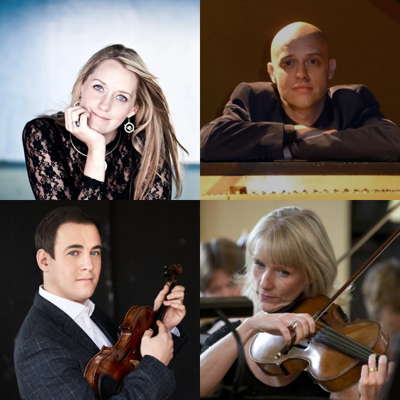- John Bingham
- Emma Lou Diemer
- Elizabeth Moak
- spinet music
- Tafreshipour
- Big Round Records LLC
- Frederic Wake-Walker
- BBC Singers
 DISCUSSION: What is a work? John Dante Prevedini leads a discussion about The performing artist as co-creator, including contributions from Halida Dinova, Yekaterina Lebedeva, Béla Hartmann, David Arditti and Stephen Francis Vasta.
DISCUSSION: What is a work? John Dante Prevedini leads a discussion about The performing artist as co-creator, including contributions from Halida Dinova, Yekaterina Lebedeva, Béla Hartmann, David Arditti and Stephen Francis Vasta.
 CENTRAL ENGLAND: Mike Wheeler's concert reviews from Nottingham and Derbyshire feature high profile artists on the UK circuit - often quite early on their tours.
CENTRAL ENGLAND: Mike Wheeler's concert reviews from Nottingham and Derbyshire feature high profile artists on the UK circuit - often quite early on their tours.
An Irresistible Fiery Vigour
MIKE WHEELER reports on a memorial concert for one of Derby Chamber Music's founding members, Jon Turner
Derby Chamber Music's current season ended with a memorial concert to Jon Turner - Multi-Faith Centre, Derby University, Derby UK, 27 April 2025 - whose initial enthusiasm was the main driving force behind setting up the society in 1997, and who died earlier this year. His favourite composer was Brahms, and with the G minor Piano Quartet, Op 25, already programmed, cellist Katherine Jenkinson's offer to switch sonatas brought Brahms' E minor Sonata, Op 38, on board, leaving Mozart's G minor Piano Quartet in place to provide contrast.
Katherine and pianist Viv McLean began the Sonata by really leaning into the sonorous opening, highlighting Brahms' love of rich, dark timbres. Cello and piano were in finely balanced dialogue, adroitly navigating the switches between the tender and the strenuous, and in complete command of where to relax the pace and where to push forward, without making it jarringly obvious. The 'quasi minuet' second movement danced graciously, with a plaintive trio section making a poignant contrast. In the finale, with its homage to J S Bach's The Art of Fugue, Jenkinson and McLean offset the muscular counterpoint with more playful moments, and the final bars were needle-sharp.
Jack Liebeck, violin, and Fiona Bonds, viola, then joined their colleagues for the rest of the programme. In the first movement of the Mozart, they made a stern pronouncement of the unison opening, but kept the second theme light on its feet. The first two movements felt a little over-romanticised, for someone who prefers their Mozart with less vibrato, but the third movement bubbled along nicely - a comic-opera ensemble for four instruments - and the startling change of key near the end made its due impact.

Clockwise from top left: Katherine Jenkinson, Viv McLean,
Fiona Bonds and Jack Liebeck
The first movement of Brahms' G minor Quartet set out purposefully; only later were there hints of the turbulence to come. The broad second theme sang, and the players explored the music's quiet inner spaces, while, at the same time, keeping the energy levels on the boil. This was a real, cohesive ensemble at work. The second movement came with just enough rhythmic skip to maintain a determined feel, allowing the trio section to do its job of lightening the mood. The following movement looks for some composure, and even manages a dancing episode, all of which the players navigated, together with the moments of sudden withdrawal, and the eventual peaceful resolution. The finale is Brahms' most rip-roaring flirtation with the Hungarian gypsy style. But this is no mere medley of gypsy-style tunes, and the players ensured that the music's connecting thread held, in spite of apparent discontinuities from one episode to the next - whether sparkling or melancholy. Overall, the performance had an irresistible fiery vigour. Jon Turner would have been the first on his feet at the end.
Copyright © 5 May 2025
Mike Wheeler,
Derby UK



